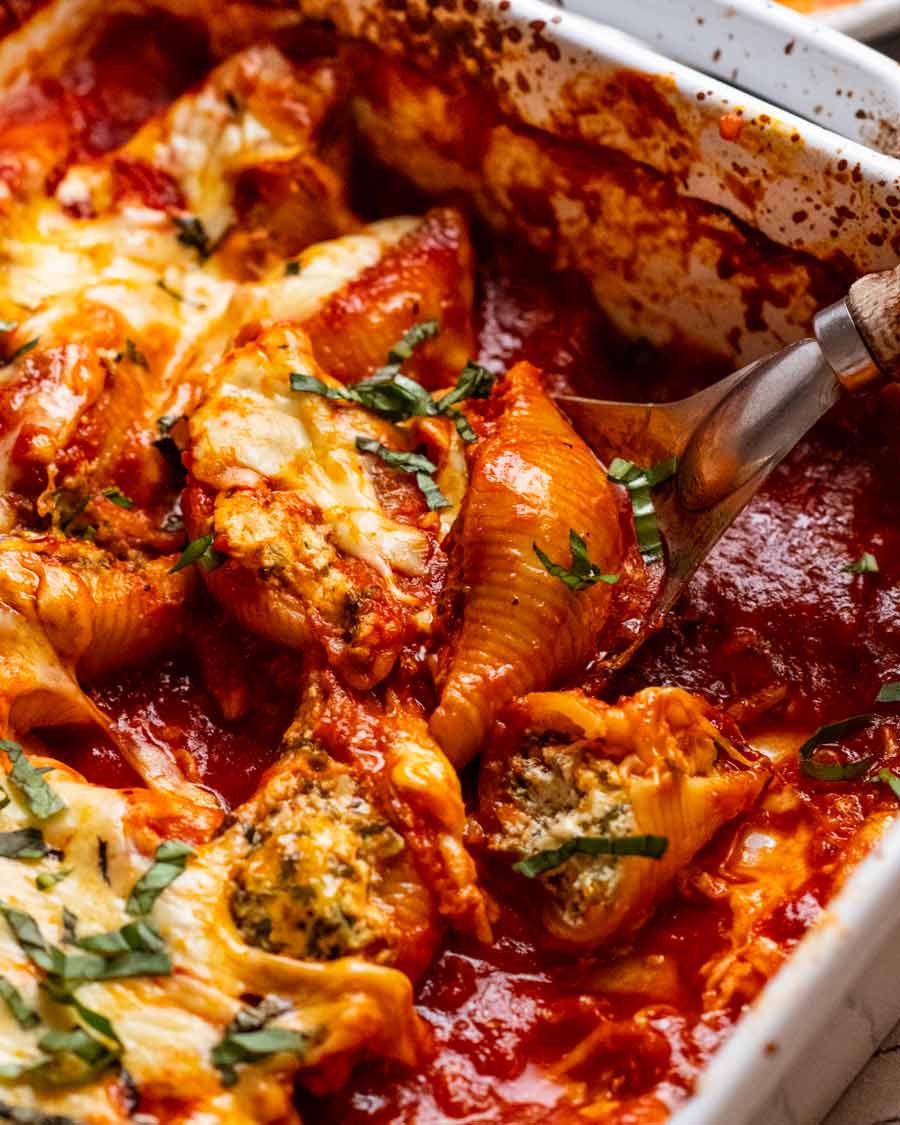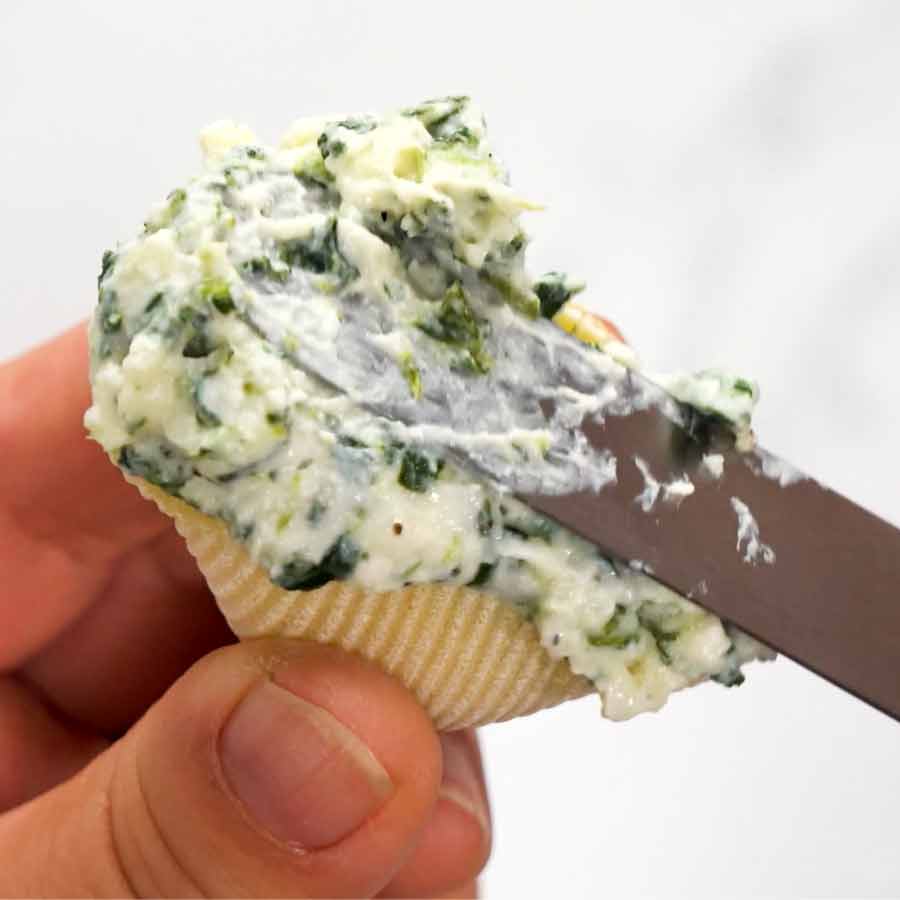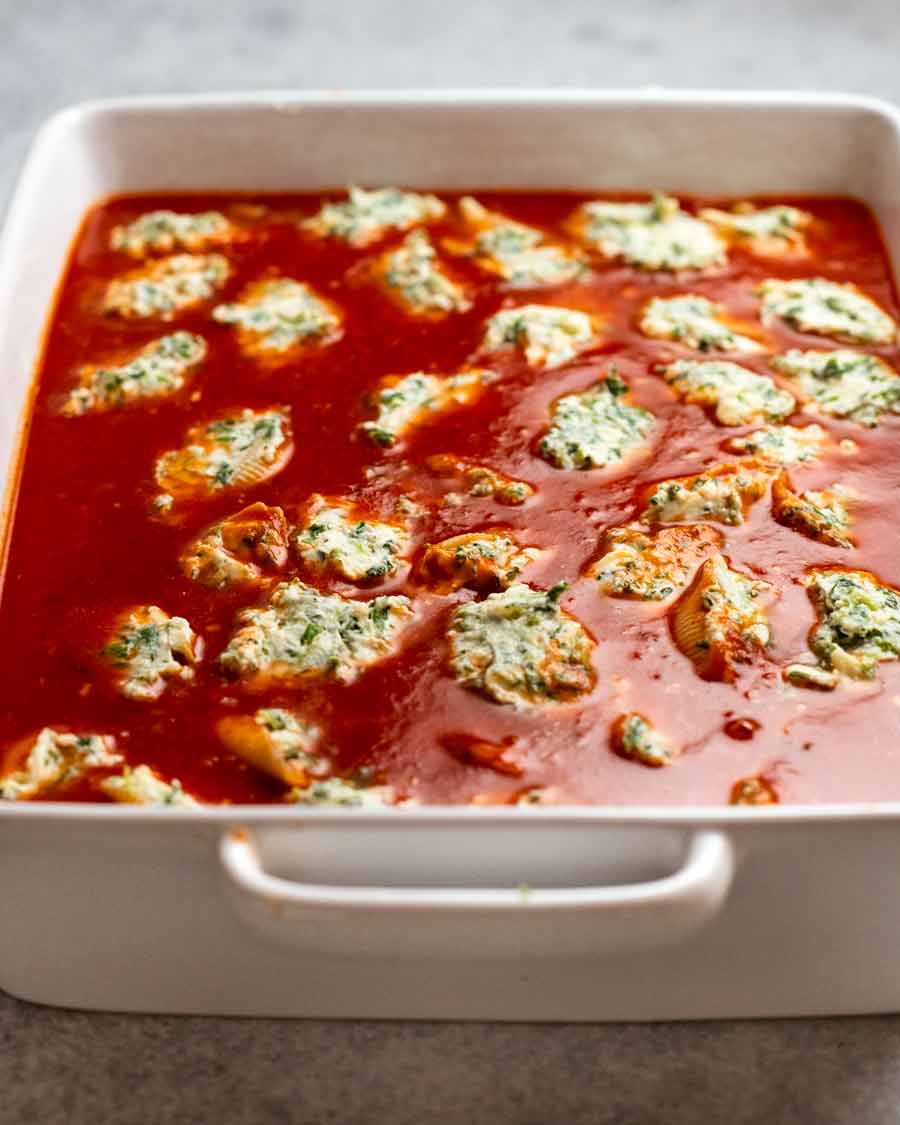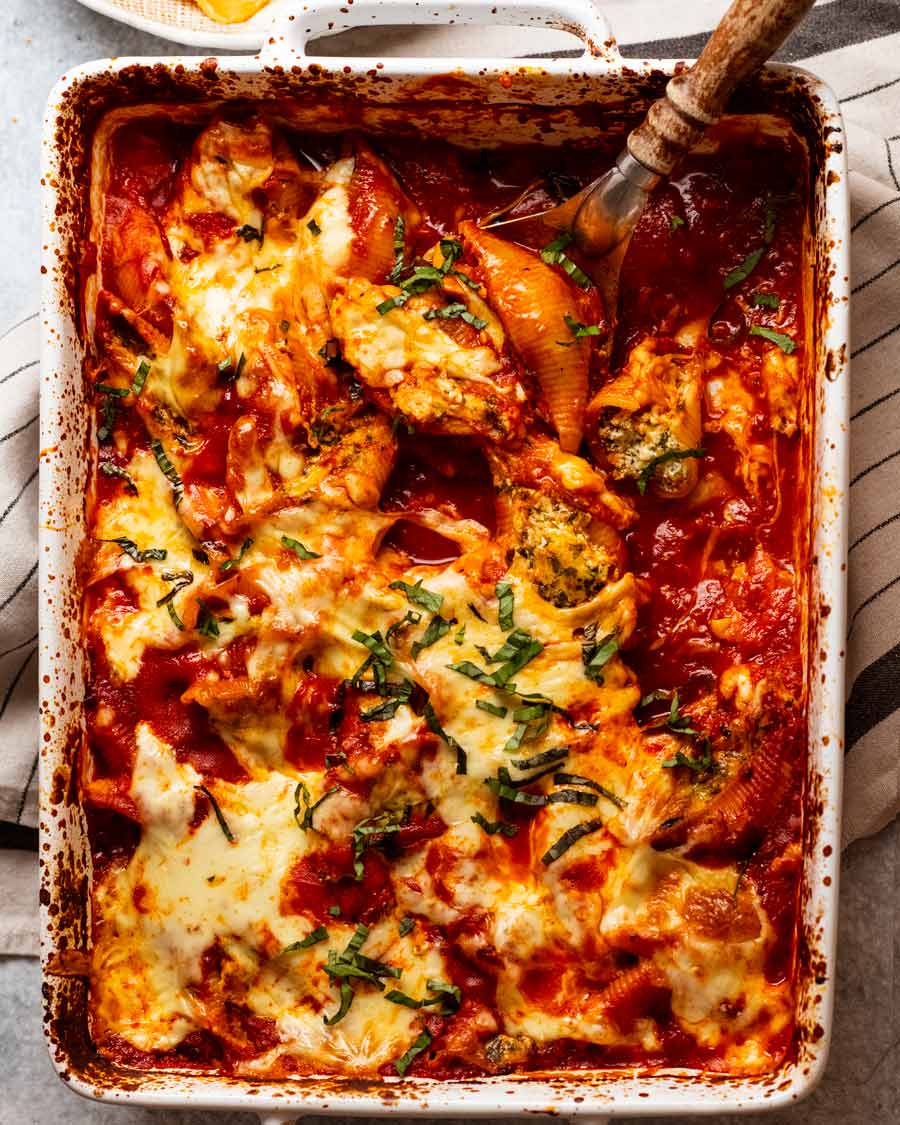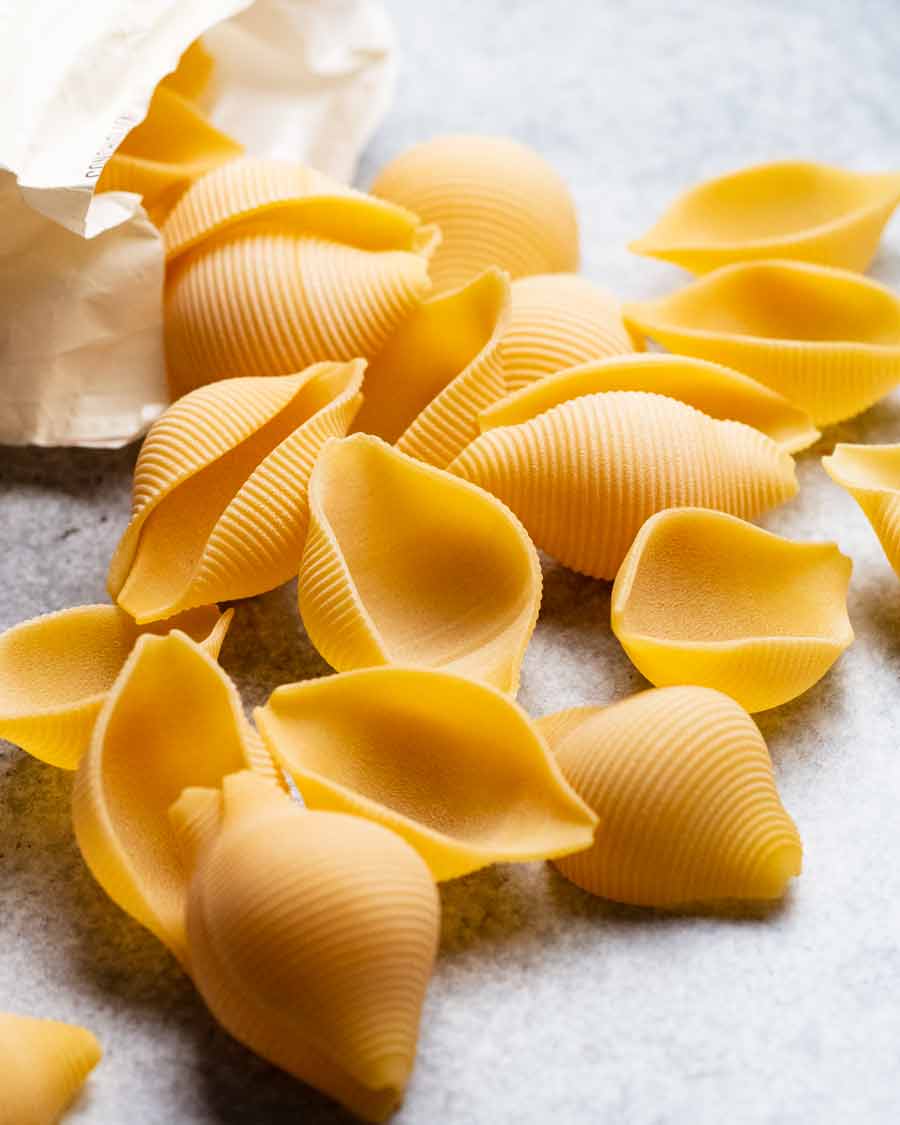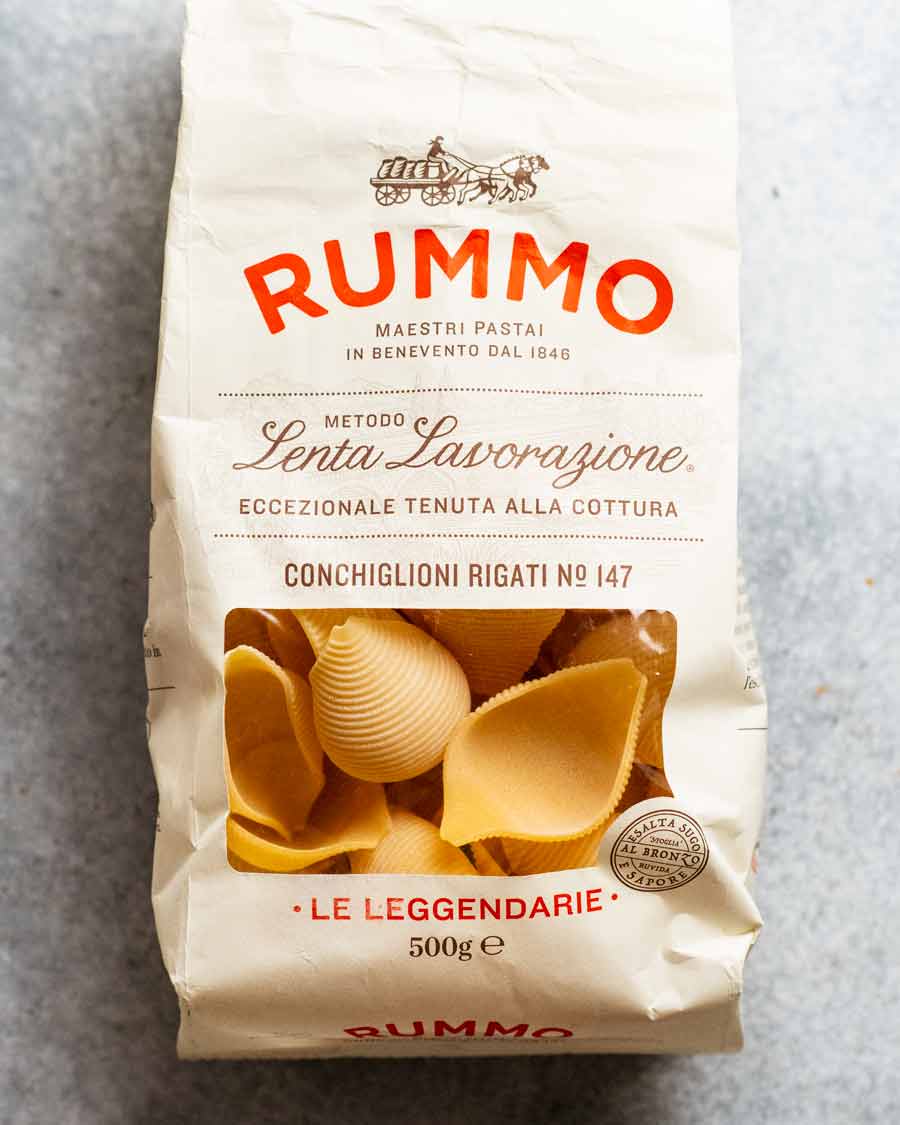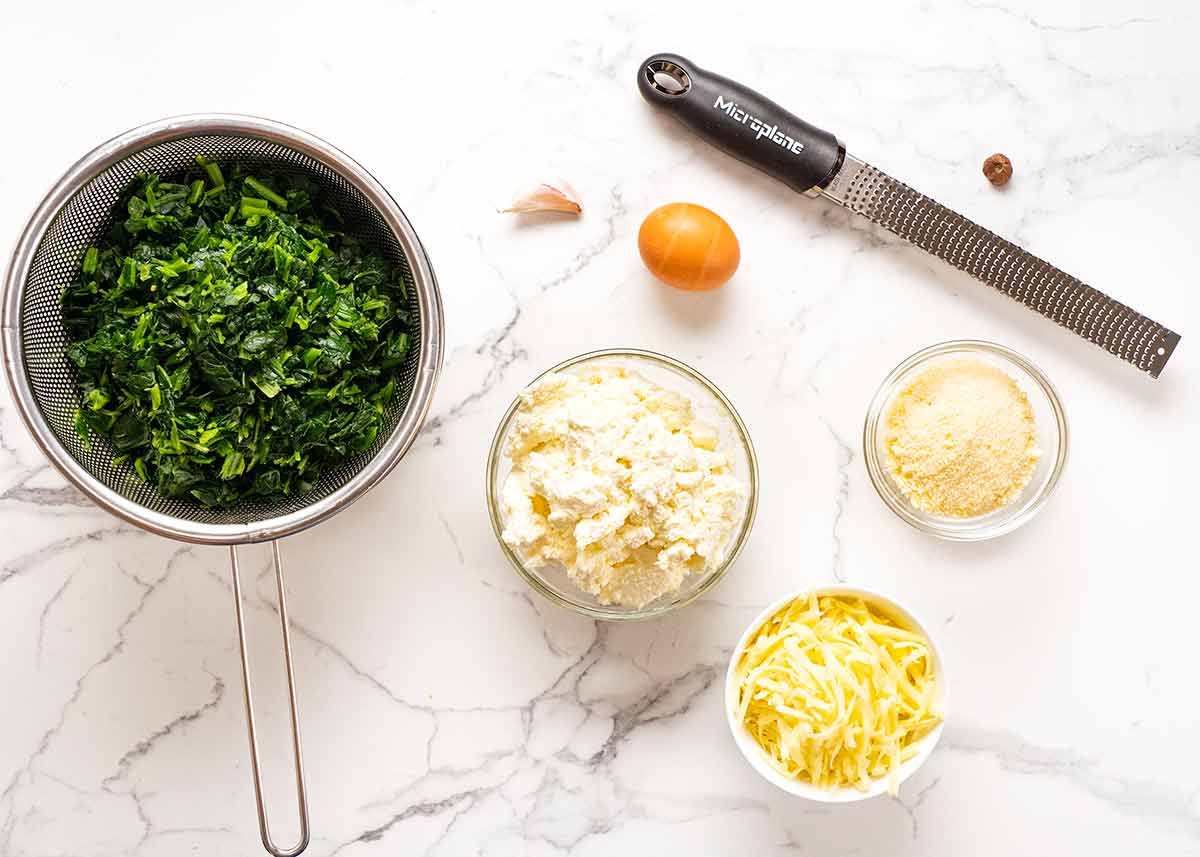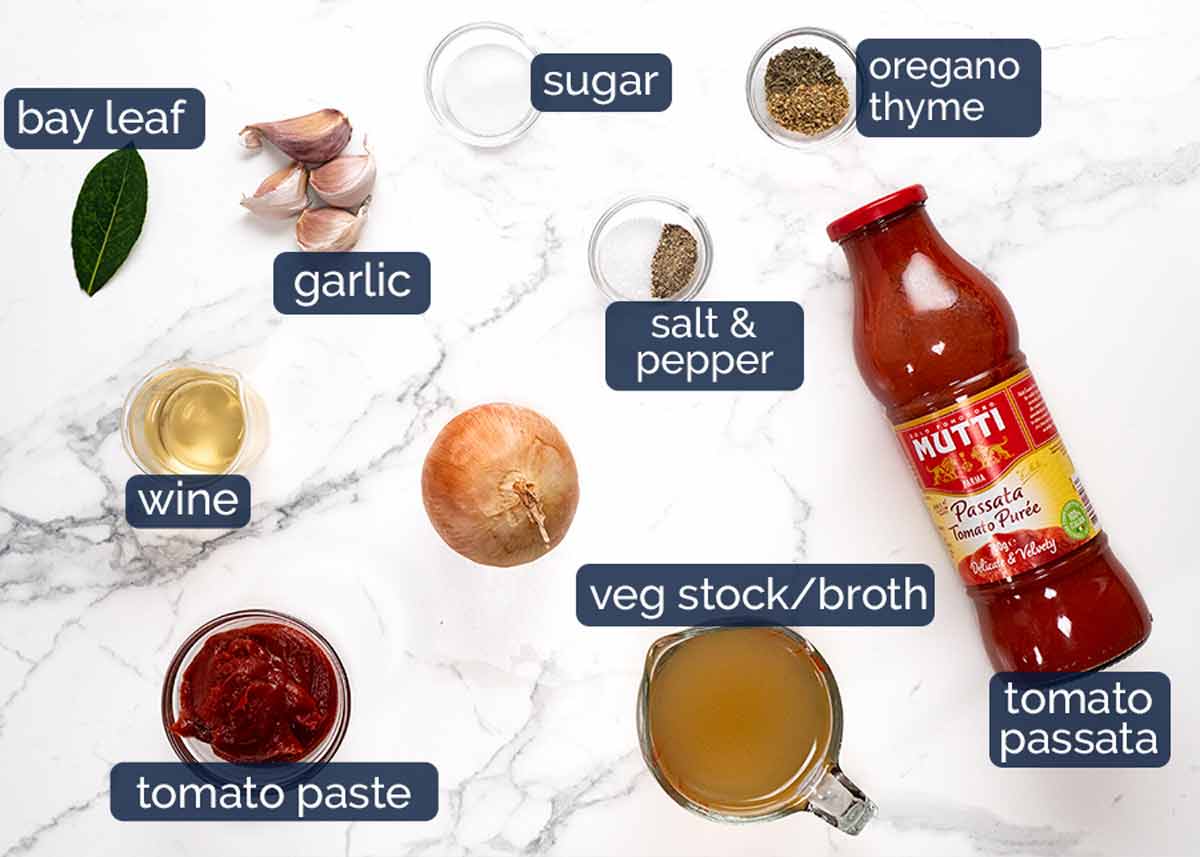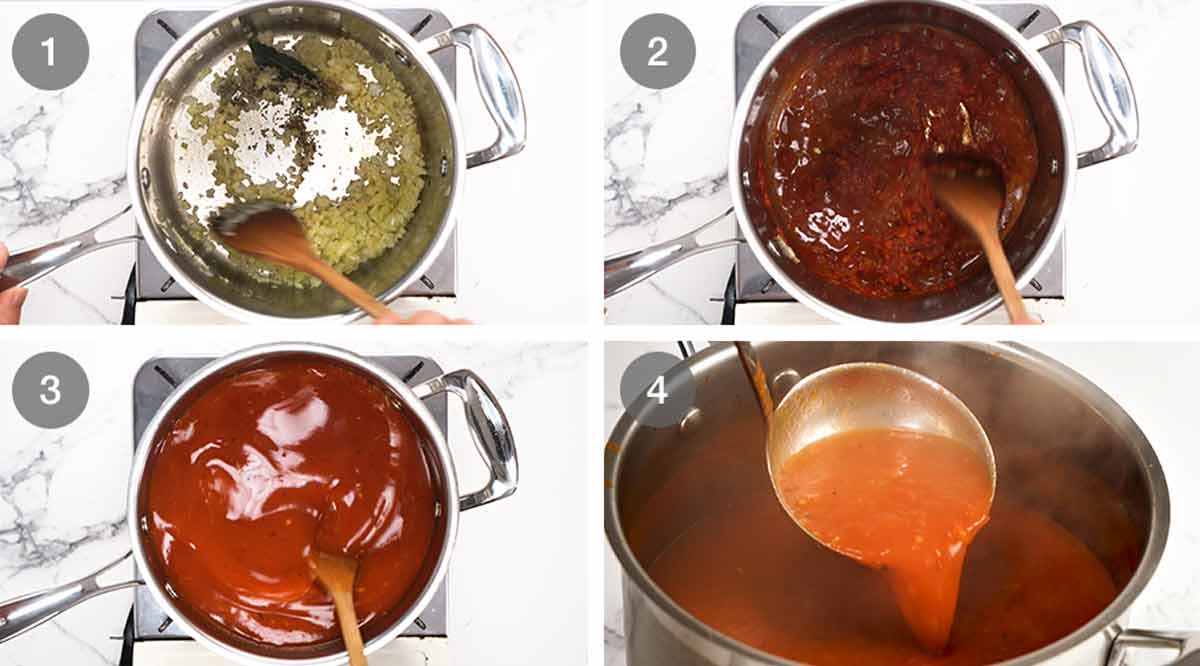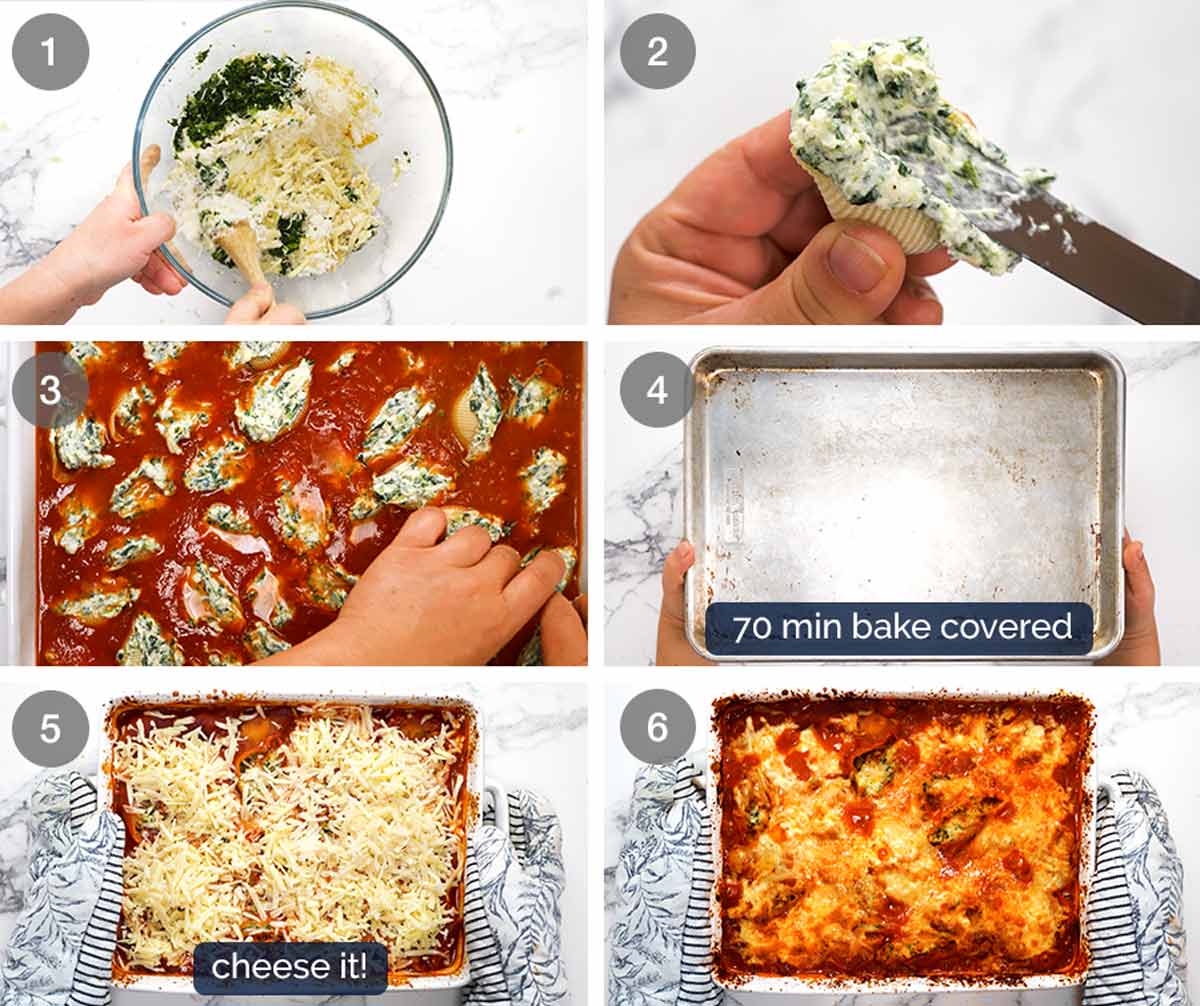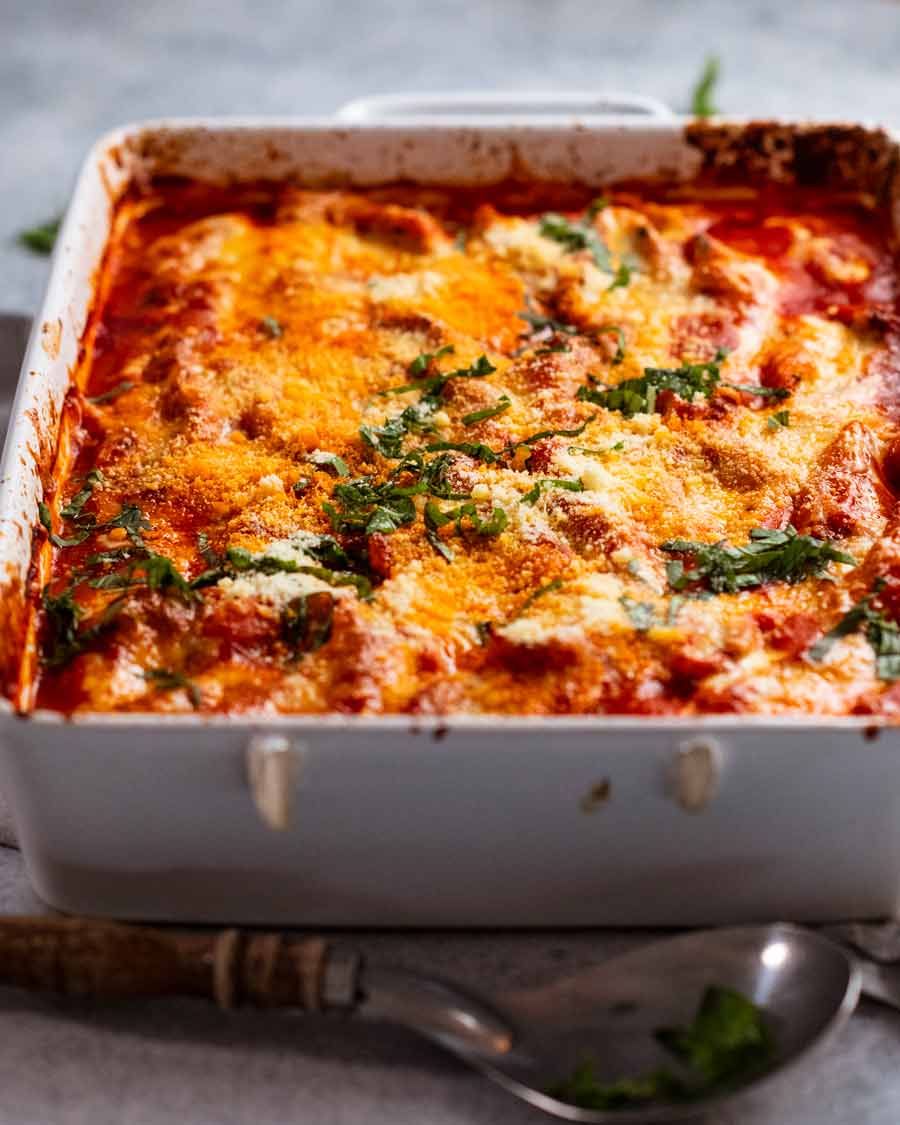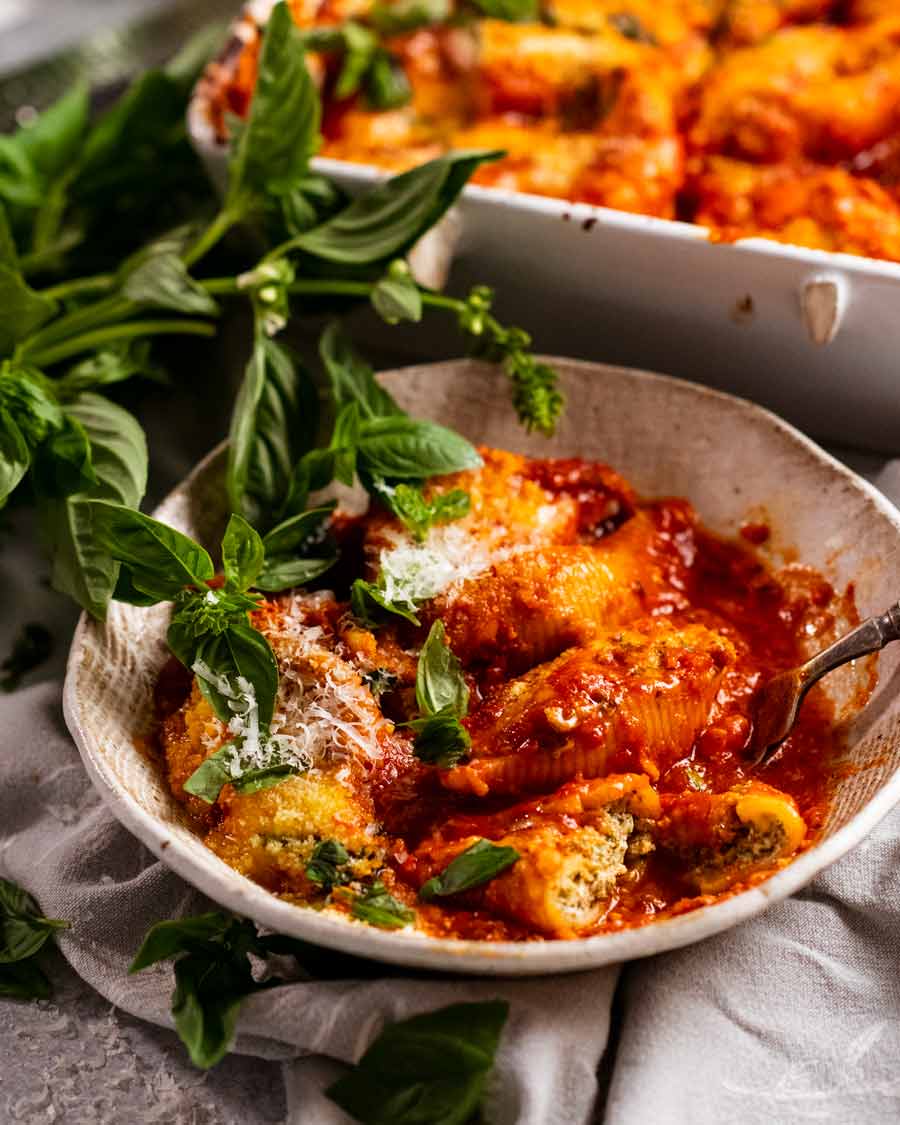Stuffed shells
I don’t know if you’ve ever tried, but stuffing hot cooked pasta shells is a nightmare. Slipper suckers that they are, and they break so easily. There’s no need to suffer through all that! It’s much easier to stuff raw, uncooked pasta shells and cook them in the oven simply by covering them in a LOT of sauce. It 100% works. It’s the way I’ve been cooking cannelloni/manicotti all my life. The trick is simply to start with a large volume of watery sauce that the pasta shells cook in. Not dissimilar to cooking pasta in a pot of boiling water, actually. And by the end, that watery sauce reduces down into a lovely thick pasta sauce! This method of cooking also deals with another pet-peeve of mine: dry pasta shells. No worries about that here, we end up with plenty of tomato sauce for serving!
What you need for stuffed pasta shells
While there’s many stuffing options for pasta shells, the most popular is probably spinach and ricotta and that’s what I’ve gone with today. Sorry for being predictable? 🙂
Jumbo shells (conchiglioni)
Jumbo shells (conchiglioni is the proper Italian name) are more readily available these days in Australian grocery stores (Woolies, Coles, Harris Farms) and the primary reason I went on a stuffed shells bender. They are a little more expensive than typical pasta shapes – around $5 for a 500g / 1 lb packet. But they go further. You’ll need 250g / 8 oz for this recipe which serves 5 generously, possibly 6. (Let me remind you, I have a rather robust appetite! My serving portions are not skimpy).
The spinach ricotta stuffing
Here’s what you need for the stuffing. Exactly the same combination I use for spinach ricotta cannelloni, spinach ricotta rolls and the fan-favourite spinach ricotta rotolo. For a meat option, use the beef filling in Beef Cannelloni instead.
Spinach – use frozen for convenience (thaw, remove excess water before using), or fresh if you’ve got an abundance of it Ricotta – be sure to use a food quality full fat, creamy one. Tip for Australians: avoid Perfect Italiano tub in the fridge aisle of major supermarkets. It’s quite powdery and unpleasant. My favourite is Paesanella which is sold at Harris Farms and over the deli counter at large supermarkets. Shredded cheese – A flavoured one is best, like cheddar, tasty, gruyere. Save the mozzarella for the topping (which melts well but doesn’t have that much flavour). Parmesan – don’t skip this! It adds extra savouriness and seasoning to the filling. Just store bought finely shredded or grated is fine, or grate your own. Garlic – because it makes everything better Egg – for binding. Nutmeg – optional, but it’s a lovely touch. I use it in almost all my spinach ricotta fillings. Salt and pepper
The sauce
I find this method of cooking stuffed shells from raw works best with a smooth pasta sauce rather than one with lumps of crushed or diced tomatoes. The shells cook more evenly and when it finishes baking, you’re left with a lovely smooth pasta sauce.
Tomato passata – Pureed, strained plain tomatoes, sometimes labelled “tomato puree” in the US (here’s a photo of Mutti tomato passata sold at Walmart). Readily available in Australian supermarkets nowadays, alongside pasta sauces. Excellent for making smooth sauces rather than simmering for ages to breakdown crushed or diced tomato. More on tomato passata here.Substitutes – US Hunt’s tomato sauce is a perfect alternative. Otherwise, use crushed canned tomato then puree (like I do for cannelloni/,manicotti). Eschalots –Also known as French onions, and called “shallots” in the US. They look like baby onions, but have purple-skinned flesh, are finer and sweeter. Not to be confused with what some people in Australia call “shallots” ie the long green onions. I like using eshalots rather than onions because they are finer so they almost disappear into the sauce so you get a lovely smooth sauce. However, you can substitute with a small onion. Herbs and spices – Fresh garlic, bay leaf, dried thyme and dried oregano. Tomato paste – To intensify the tomato flavour and thicken the sauce slightly. White wine – Adds depth of flavour / complexity into the sauce in a way only wine can! It’s only 1/3 of a cup and we simmer to cook out the alcohol. Substitute with more stock, or just skip it. Vegetable stock – We need a whole litre / quart (4 cups) because we’re making a LOT of VERY watery sauce here! Just watch the video and you’ll see how it all gets absorbed by the pasta shells, leaving behind a lovely thickened pasta sauce for serving. Sugar – Just a smidge, to take the sour edge off the tomato paste we’re using (tomato paste is sour!).
How to make stuffed shells
It’s actually extremely straight forward and the recipe has a nice flow to it: make the sauce first, then while it’s simmering, stuff the shells. Then assemble and bake! Substitutes – US Hunt’s tomato sauce is a perfect alternative. Otherwise, use crushed canned tomato then puree (like I do for cannelloni/,manicotti). I like using eshalots rather than onions because they are finer so they almost disappear into the sauce so you get a lovely smooth sauce. However, you can substitute with a small onion.
How to make sauce for stuffed shells
Stuffing & bake
Why a baking tray? Easy way to cover the baking dish, no waste, no burning yourself, and it lets a little bit of steam escape to help the sauce reduce just the right amount. Serve with a quick rocket balsamic salad (that’s arugula, to those of you in the States!) or if you’re out to impress, a Mega Italian Salad (it lives up to its name). Add a side of garlic bread and tiramisu to finish, and that’s pretty much my idea of a perfect dinner. When am I coming over?? – Nagi x
Watch how to make it
Life of Dozer
Wow. He really will eat anything.
